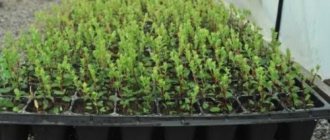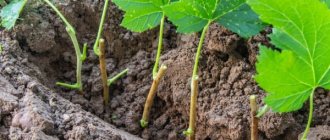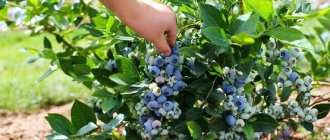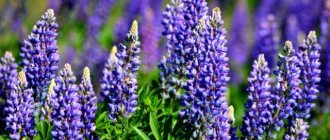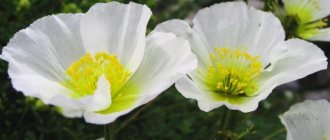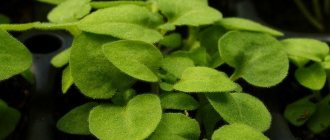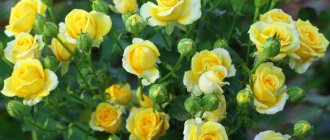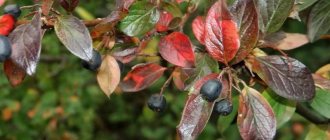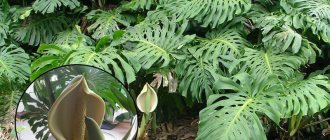What is Thuja Smaragd
There are many varieties of thuja, but the western smaragd belongs to the conical varieties and is one of the most sought after due to its qualities. This tree belongs to the coniferous species. It is chosen for its even cone-shaped shape, large height and bright green color, which lasts throughout the year. Even extreme cold does not harm emerald needles. Thuja occidentalis Smaragd is considered the most beautiful representative of its genus.
Description
This type of thuja is not yet 70 years old; it was bred in 1950. Denmark is considered the birthplace of the variety. The plant is highly wind and frost resistant, very unpretentious, grows on any soil and in any area, and purifies the air. Has a shallow root system. Caring for it is extremely simple and does not take much time and effort. The branches grow vertically upward, far apart from each other. They look glossy and always fresh green. The more humid and sunny the planting site, the greener and denser the thuja will be. In dry places, the dense crown thins out slightly.
Mature plant height
When choosing this tree for planting, you need to take into account that over time the appearance will change greatly. A small thuja seedling will gradually grow into a giant with an average height of 5-6 meters. If you plant thuja under windows, keep in mind that it will soon block your entire view. But the plant looks great as a hedge or garden composition. Different varieties may differ in height, for example, Smaragd variegata reaches only three meters in adulthood.
How much does it grow
Thuja smaragd grows very tall, which takes a lot of time. Depending on the variety, growth can reach from 10 to 50 centimeters per year. The tree will delight with its emerald greenery for several decades: from 50 to 150. In four years, the western smaragd species reaches a height of about 2.5 meters, the diameter of the crown is about 70-80 centimeters.
Description Western thuja Smaragd (Thuja occidentalis Smaragd) is a coniferous tree with a narrow conical dense compact-symmetrical crown (diameter up to 1.8 m) and evergreen scaly shiny needles of a dark emerald color.
Thuja smaragd is a typical representative of the western thuja. Its height reaches up to 5 m. The best variety of conical thuja. The fruits are round, cone-shaped, brown, 0.7 cm in size.
Growth is slow. Over the course of a year, Thuja Smaragd grows only 10 cm in height and 5 cm in width. She is very easy to care for and lives a very long time. Adapts perfectly to different climatic conditions. It can grow on almost any soil, even one that is not characterized by fertility and moisture. Tolerates urban conditions well. It is used in different types of plantings (single, group, hedges, containers).
It is better to plant in places protected from the wind. If groundwater is close, drainage consisting of crushed stone with a layer of 10-20 cm is required.
Winter hardiness is quite high; in some years it can burn in the bright spring sun, but in spring and summer it quickly recovers. In winter, to prevent damage to the crown, it is recommended to shake it off after snowfalls with wet snow. USDA zone 3 (see Climate Zones).
Thuja Smaragd is simply irreplaceable for landscaping a garden plot.
Planting and caring for thuja occidentalis Smaragd
For planting thuja, choose sunny places. Although the plant tolerates shade, the plant develops worse and the crown becomes less attractive. The soil is light (peaty, dry and clayey sandy loam). When planting in heavier soil, a drainage layer of at least 15 cm thick is required at the bottom of the planting hole. The planting hole is dug to the size of the plant clod, with a depth of 60 to 80 cm. The soil mixture can be prepared in advance. A mixture consisting of sand, peat and leaf (turf) soil in a ratio of 1:1:2 is optimal. The acidity level for thujas is desirable within the range of 4.5-6 pH (see What is soil acidity: determining and regulating pH). For better growth, add nitroammophoska (up to 100 g per adult plant). It must be remembered that the root collar should be at ground level.
After planting, thuja must be watered regularly, about once a week with one bucket of water per adult plant. If planting was carried out during a hot, dry period, then the frequency of watering must be increased. Thuja is a plant that evaporates a lot of moisture, so it loves watering and sprinkling and responds well to it.
Fertilizing is usually carried out in the spring; any complex fertilizers (Kemira-Universal, etc.), 50-60 g per m2, are suitable for this.
When the growing season begins, the soil is loosened to a shallow depth (10 cm), so the thuja has a shallow root system, and mulched (with compost, peat, bark, etc.)
The adult plant tolerates winter frosts well. However, thujas suffer from sunburn in the spring. Therefore, they need to be covered, especially young plants (see Sheltering coniferous plants for the winter). In winter, the crown is tied tightly with tape to prevent damage to the crown from wet snow. In spring, damaged dry shoots are removed and sanitary pruning is carried out (see Types of pruning of green spaces).
Main varieties of thuja Smaragd
This species can be divided into several popular varieties. Each has its own characteristics, reaches different heights, and grows at different speeds. The most common and popular types are:
- Thuja golden smaragd (golden). The name comes from the golden yellow hue of the crown. The tree's shoots are short and densely arranged. In 10 years it grows 2 meters. Great for hedges.
- White Smaragd (white). This subspecies differs from the first in the color of the crown. It is undemanding, but prefers to grow in damp places. The higher the air pollution (as in a city), the slower the growth.
- Smaragd Variegata. The crown is conical, narrow, and the shade remains bright green throughout the year. It is distinguished by its white color, in which the ends of the shoots are painted. Due to this feature, the tree looks decorative and is suitable for transforming rocky areas.
- Smaragd Vitbont. One of the slowest growing trees of this species. Mainly used only where there is a need for long-lasting plantings, such as hedges.
- Spotty Smaragd (spotty). It has a pyramidal crown shape. The density of the branches is weak, but creates a voluminous, lush appearance.
- Spiral. The name comes from the unique spiral shape of the tree. It looks great alone, in a group of other plantings, or rock gardens.
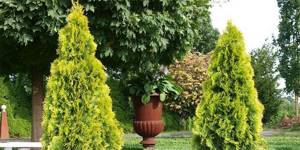
Various types of thuja
To improve garden plots, various types of thuja are used, which are combined with each other. Smaragd is especially in demand. Nurseries engaged in growing such plants are ready to offer different varieties of Smaragd in bulk, which have some external differences.
All types of juniper are characterized by high phytoncidity and strengthen the immune system.
Thuja Golden Smaragd
Let's consider the description of this thuja and its use in the garden landscape. Golden Smaragd stands out for its unusual crown color: it is golden-yellow with a greenish tint. The shoots are short and densely spaced along the height of the tree. The growth rate is average: by the age of 10, the thuja reaches a height of 2.5 meters. The height of an adult plant is about 5 meters. Golden Smaragd began to be grown in dachas and garden plots in 2009. The variety was bred by the Pole Edward Kubik. The tree is characterized by average frost resistance. Therefore, it is recommended to grow it in the central and southern regions.
Thuja White Smaragd
White Smaragd is one of the best varieties of western thuja, which is suitable for single, group plantings, and creating hedges. It is distinguished by a light green, sometimes whitish, crown of an ideal conical shape. The needles do not change their color throughout the year. Growth is moderate: by the age of 10, the height of the tree reaches 2 meters. The cones are ovoid, oblong, about a centimeter long. Painted brown. The variety prefers sunny places: in the shade the needles begin to lose their unusual shade.
Smaragd Variegata
The variety is characterized by a regular narrow conical shape. The height of an adult plant does not exceed 3 meters. The color of the thuja is bright green throughout the year. The branches are closely spaced to each other. An interesting feature of Smaragd Variegata is that the ends of the shoots are painted white. This makes the tree decorative, and original compositions are obtained. In landscape design, thuja is often used to transform rocky areas, design slides, terraces, and rock gardens. Variegat is often used to create hedges and fences.
Witbont
It is a mutation of the western thuja Smaragd. Vitbont is the best option for creating long-lasting plantings. The variety has a slow growth rate: annual growth is 20 centimeters. By 10 years the tree reaches 3 meters. The diameter is about a meter. The crown has a dense conical shape, colored emerald with white-cream tips. By autumn the shade becomes light green. The needles are scaly, thick and tender. The plant is compact. The branches grow vertically and are densely spaced. The bark is grey-brown.
Thuja Spotti Smaragd
It stands out for its unusual needle structure, which creates a feeling of volume. The crown has a narrow conical shape. Painted green with milky splashes. The height of an adult tree is several meters. The width does not exceed a meter. The variety is shade-tolerant and frost-resistant. Prefers fertile, fresh soil. The growth rate is slow. The annual growth is 4 centimeters in width and 10 centimeters in height. The cones are oblong-ovate, sparse, brown in color. Spotti is suitable for single and group plantings and creating hedges.
Columna
Columna, like Smaragd, belongs to the species of western thuja. Columna's crown shape is narrowly columnar. The height of the tree is 8-10 meters. The annual growth is 25 centimeters. The needles are shiny, scaly, dark green. Smaragd is distinguished by its conical crown shape. The height does not exceed 6 meters. Growth - 10 centimeters per year. Both types are easy to care for. They tolerate drought and partial shade well, are durable and frost-resistant. Which type is better: Smaragd or Columna - depends on the taste preferences of the gardener.
Brabant
In addition to thuja Smargad, landscape designers also use Brabant. This is a good option for those who want to create a hedge in the shortest possible time. After all, the annual growth of Brabant is 0.5 meters. The crown is pyramidal. To keep it fluffy and dense, it is cut twice a season. The needles are light green. Thuja is characterized by its love of light and its ability to tolerate waterlogging. But frost resistance is low.
Smaragd is distinguished by a more saturated color of its needles and high decorative qualities. The crown is conical, lush, and does not require frequent pruning. Shade tolerance is good. Thuja can withstand frosts down to -40 degrees.
How to plant thuja correctly
The tree can be planted from early spring to autumn. Each season has its own characteristics in how to plant thuja emerald, since it affects the plant differently, but at any time it is important to remember that a young seedling loses a lot of moisture through the crown. To avoid this, from the end of winter it is worth covering the young thuja with an awning that creates shade, otherwise it may get burned and die. Otherwise, the seedling is not very demanding and the planting rules will be as follows:
- It is better to choose sunny areas for the location. It is advisable that it is not blown by the wind.
- Dig a hole 2-3 times wider than the root ball, create a drainage layer, and place more sand there.
- The bottom of the hole must be sprinkled with ash.
- It is very important to completely immerse the root collar underground, otherwise the seedling may die.
- Water the tree thoroughly.
in autumn
Planting thuja emerald in the fall is not the easiest task. The tree may die due to the lack of a strong root system. Strong autumn winds will tilt the young tree and the ground will sag. It is important to carefully secure the seedlings for the winter using guy ropes. Near the lump you need to install stakes to protect the tree from damage. Even careful care may not save a thuja planted in the fall from death, because it will not have time to take root.
in spring
The optimal time for planting a decorative evergreen tree is early spring. It is recommended to plant thujas during this period, since sap flow has not yet begun. The shoots and root system have not begun to grow, so they tolerate replanting better. It is important that the cold of the first spring month still keeps the ground frozen, so the root ball dug out of the ground will not fall apart and be injured. A minimum of roots will dry out. The plant will have a long favorable period ahead for the root system to grow and strengthen.

- How to make pancakes
- Strip plastic for beginners with video. The benefits of strip plastic exercises for weight loss and the cost of training
- How to measure basal temperature to determine ovulation or pregnancy with a regular thermometer
Digging up an adult thuja for subsequent tree transplantation
March 20th, temperature at night -1, daytime +5. Not finding adequate and unambiguous advice on the Internet, we supervised only common sense when replanting a tree, namely:
- We replant the thuja in the cold season, before the active movement of juice occurs. This reduces the need for water and increases its survival rate. With a large earthen lump, the tree will tolerate replanting painlessly. Carrying out work in the heat so that “the roots grow faster” is outright nonsense of distant gardeners. Thujas are not tomatoes. And tomatoes don’t survive well in hot weather!
- We reduce the load on the root system, removing approximately 30% of the green mass of the tree. The decision seemed quite reasonable, especially since the thuja was neglected and crooked; without damaging the tree and its aesthetics, it was possible to remove the top and 15% of the branches inside the crown.
- We form a larger earthen ball so that at least 50% of the root system remains. For thuja variety Smaragd - approximately 0.5 cubic meters of land.
- We pre-moisten the digging site and planting site to make the roots less brittle and saturate the plant with moisture.
After briefly trimming the thuja and trimming the top, we filled it with water and left it to stand for half a day so that the roots would absorb moisture and become less brittle. In the evening, when it got colder and the sun had set, we decided to start digging up and replanting the thuja Smaragd. Digging began at a distance of 1 m in diameter from the trunk, constantly tapering to a cone 1 m in depth.
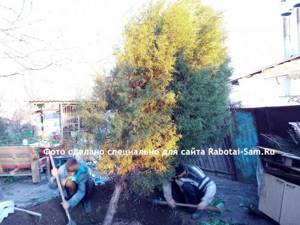
Having received such a cone, we cut off the main roots below and remove the thuja with an earthen lump. The weight will be within 250 kg; with the help of 4 people and 2 wooden blocks for ease of transfer, you can transport it without any problems.
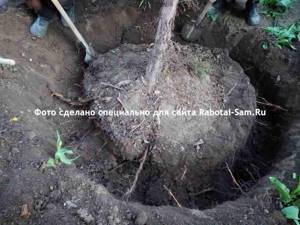
going deeper “under the cone”
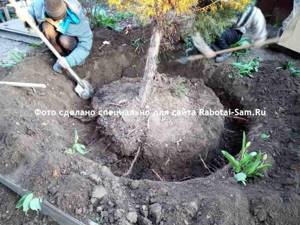
we begin to dig up thuja
Care
After planting, it is important to provide the tree with proper care. It starts with watering. Every week you need to pour one bucket of water under each plant. If the weather is dry, the frequency of watering can be increased. In summer and spring you need to spray the crown. It is better to do this daily in the morning. Mulching helps retain moisture. In addition, it protects the roots from overheating in very hot weather. In autumn, this procedure helps to retain heat in the ground. Mulch can be made from sawdust, grass, leaves. There are ready-made circles made from coconut fibers on sale.
Young thuja needs protection from wind and cold, so for the first few years in winter the branches need to be tied. Otherwise, they may break under the weight of snow and gusts of wind. Even frost-resistant thuja needs shelter at low temperatures until it gets stronger. Spruce spruce branches and any covering material are suitable for this. The latter must transmit light, since photosynthesis of evergreen needles occurs all year round. The tree tolerates cutting to give it shape when it grows several meters. It is useful to loosen the soil, doing it carefully.
How to accelerate growth
Thujas are characterized by moderate growth, so gardeners are looking for ways to make this process faster. This can be achieved in several ways:
- Provide the tree with good regular watering, constantly moist soil, trying not to harm it, since excess water is destructive even for moisture-loving thuja. Not only the roots, but the crown need hydration. On a young tree it should be sprayed as often as possible.
- Pruning promotes accelerated growth. It is held in the spring, starting from the third or fourth year. It is necessary to trim about 10 centimeters of the top.
- Feeding coniferous plants also gives growth. It starts from the second year. The composition of fertilizers includes phosphorus, potassium, and microelements.
How to care for thuja depending on the season
The period after landing. It is imperative to provide a humid environment; for this you need to carry out regular watering, about once a week; it is best to completely moisten the thuja using the sprinkling method.
- Summer. It is the hottest time of the year, so it is very important to give the plant as much moisture as possible and do not forget to water it on time, preventing the soil from drying out. also necessary to cover the entire root area with mulch so that the soil retains water inside itself for as long as possible; crushed pine bark chips are ideal for these purposes. Among other things, in August the tree must be fertilized with minerals.
- Autumn. The time comes when it is necessary to prepare the tree for the coming cold weather; for this, you first need to apply potassium fertilizers, which will be additional nutrition for the root system. To avoid tree breakage, special supporting structures are built, and tree branches can be additionally tied. And to avoid freezing and yellowing, the thuja needs to be covered with a tarpaulin or something similar for the winter . It is worth noting that these procedures should be carried out only with a tree that has not yet had time to get stronger; adult specimens have excellent frost resistance and are able to withstand any temperature changes.
- Winter. It is necessary to maintain the viability of trees, protecting them from cold weather and sharp gusts of wind.
- Spring. After freezing, the tree could, at least partially, be damaged, so it is necessary to carefully check and trim all diseased branches so that the disease does not spread further. It is also in spring that it is recommended to do decorative pruning to give it shape. In April-May you need to apply complex fertilizers, which will serve as a good impetus for new growth.
Reproduction
The main method of propagation of thuja and ornamental trees of this type is cuttings, seeds, and planting seedlings. The fastest way is to buy ready-made seedlings with a container from the nursery and simply plant them. The second option takes about 3 years. It is best to carry out the cutting procedure in the spring; in the summer the cuttings may not survive. This is done as follows:
- Cut 12cm branches.
- Cut off the base, leaving a length of 5 centimeters. The angle of the cut should be 45 degrees.
- At the base of the cut, you need to remove the bark, leaving the foliage only on top.
- Place the prepared cuttings in water.
- Leave until roots appear.
- After roots appear, prepare a planting mixture. It is made from compost, sand, vermiculite. Place the mixture in the pot, leaving it empty 5 centimeters from the edge. There should be drainage holes in the bottom.
- Gently blot the cutting with a napkin, which will absorb the liquid.
- Soak the sprout in growth hormone, place it in a pot, sprinkle it with soil, and water it.
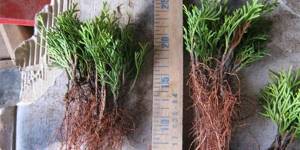
The use of thuja Smaragd in landscape design
The shape of this type of thuja can be called almost ideal, so it can fit into any landscape design and give it a finished, well-groomed look. The variety of emeralds is suitable for:
- growing dense hedges from group plantings that can close any garden area from prying eyes;
- single plantings, in group compositions, as a central decoration of the garden, especially the Spiral variety;
- decoration of the facades of high-rise buildings;
- creating garden alleys;
- registration of entrance to the territory.
Description and characteristics of an evergreen plant
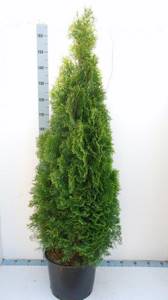
The tree is an ornamental plant, which means it belongs in a natural or artificial landscape. A hedge made of thuja Smaragd looks royal, and it’s up to you whether to make it slender and uniform or to allow each tree to grow in its own way, preserving its originality. Features and characteristics of thuja western Smaragd will help you get to know this amazing plant better:
- The height of an adult thuja Smaragd plant usually varies in the range from 4 to 6 m, and the untreated width is up to 2 meters.
- Average life expectancy is 110-130 years. If we talk about how quickly Thuja Smaragd grows, then on average, per year the tree grows no more than 20 cm in length and 4-5 cm in width.
- Thuja occidentalis Smaragd is one of the most popular representatives of the cypress family.
- The tree has the shape of an oblong cone with a pronounced crown and a thick coniferous covering. It is very malleable, which is why landscape designers love to give it different sculptural forms.
- Thuja Smaragd is an evergreen plant, which means it will remain so even in winter and after a hundred years.
- In spring, thuja blooms with small oblong brown cones, which fall off with the onset of autumn cold weather.
- Thuja feels great even in the cold Russian winters, since it has enviable frost resistance.
- The tree grows on any Russian soil and requires minimal care.
- Thuja grows not only in gardens and vegetable gardens, but also within the city. A polluted environment does not have any negative impact on the ripening of this tree.
- Thuja western Smaragd actively releases phytoncides, especially during its flowering period, due to which it purifies the air and saturates it with useful substances.
- The plant looks equally impressive in the form of a single planting and in a hedge environment.
- Thuja Smaragd occidentalis is most often divided into 2 main subspecies: thuja with a green color and thuja with a golden color.
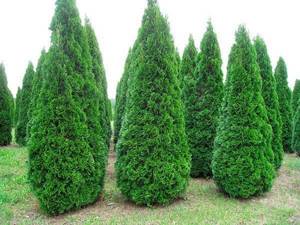
Now you know the description of the photo of the western Smaragd thuja, and you can easily distinguish it from other species.
